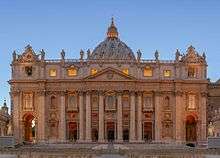Catholic Church and Islam
Relations between the Catholic Church and Islam deals with the current attitude of the Catholic Church towards Islam, as well as the attitude of Islam towards the Catholic Church and Catholics, and notable changes in the relationship since the 20th century.
| Part of a series on the |
| Catholic Church |
|---|
 |
| Overview |
|
Miscellaneous
Relations with: |
|
|
Second Vatican Council and Nostra aetate
The question of Islam was not on the agenda when Nostra aetate was first drafted, or even at the opening of the Second Vatican Council. However, as in the case of the question of Judaism, several events came together again to prompt a consideration of Islam. By the time of the Second Session of the Council in 1963 reservations began to be raised by bishops of the Middle East about the inclusion of this question. The position was taken that either the question will not be raised at all, or if it were raised, some mention of the Muslims should be made. Melkite patriarch Maximos IV was among those pushing for this latter position.
Early in 1964 Cardinal Bea notified Cardinal Cicognani, President of the Council's Coordinating Commission, that the Council fathers wanted the Council to say something about the great monotheistic religions, and in particular about Islam. The subject, however, was deemed to be outside the competence of Bea's Secretariat for the Promotion of Christian Unity. Bea expressed willingness to "select some competent people and with them to draw up a draft" to be presented to the Coordinating Commission. At a meeting of the Coordinating Commission on 16–17 April Cicognani acknowledged that it would be necessary to speak of the Muslims.[1]
The period between the first and second sessions saw the change of pontiff from Pope John XXIII to Pope Paul VI, who had been a member of the circle (the Badaliya) of the Islamologist Louis Massignon. Pope Paul VI chose to follow the path recommended by Maximos IV and he therefore established commissions to introduce what would become paragraphs on the Muslims in two different documents, one of them being Nostra aetate, paragraph three, the other being Lumen gentium, paragraph 16.[2]
The text of the final draft bore traces of Massignon's influence. The reference to Mary, for example, resulted from the intervention of Monsignor Descuffi, the Latin archbishop of Smyrna with whom Massignon collaborated in reviving the cult of Mary at Smyrna. The commendation of Muslim prayer may reflect the influence of the Badaliya.[2]
In Lumen gentium, the Second Vatican Council declares that the plan of salvation also includes Muslims, due to their professed monotheism.[3]
See also
- List of converts to the Catholic Church from Islam
- Catholic Church in the Middle East
- Catholic Church and Judaism
- Christianity and Judaism
References
- (History of Vatican II, pp. 142-43)
- (Robinson, p. 195)
- Lumen gentium, 16 Archived September 6, 2014, at the Wayback Machine